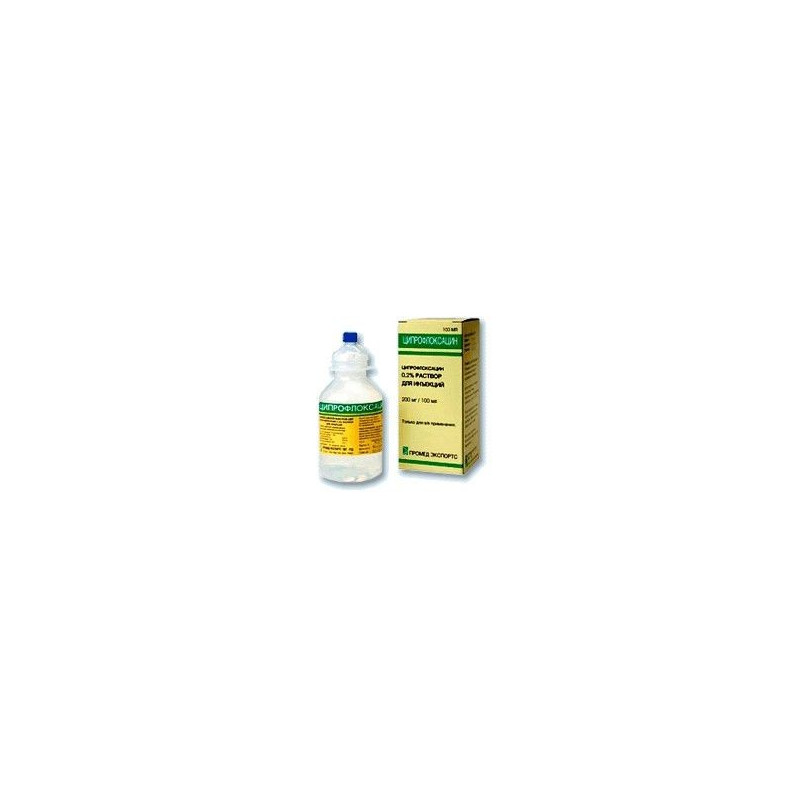



 All payments are encrypted via SSL
All payments are encrypted via SSL
 Full Refund if you haven't received your order
Full Refund if you haven't received your order
Solution for injection
Each 100 ml of solution contains 200 mg of ciprofloxacin in the form of lactate.
Bottle of 100 ml.
Ciprofloxacin is a broad-spectrum antimicrobial agent from the group of fluoroquinolones. Bactericidal effect. The drug inhibits the enzyme DNA gyrase of bacteria, as a result of which DNA replication and synthesis of cellular proteins of bacteria are violated. Ciprofloxacin acts both on the breeding microorganisms and on those in the resting phase.
Ciprofloxacinactive against gram-negative aerobic bacteria: Escherichia coli, Salmonella spp., Shigella spp., Citrobacter spp., Klebsiella spp., Enterobacter spp., Proteus mirabilis, Proteus vulgaris, Serratia marcescens, Hafnia alvei, Edwardsiella tarda, Providencia spp., Morgan and friend, business, business, business, business, business, business, business, business, business, business, name, class, name, name, class, name, class, name, name, name, name spp., Haemophilus spp., Pseudomonas aeruginosa, Moraxella catarrhalis, Aeromonas spp., Pasteurella multocida, Plesiomonas shigelloides, Campylobacter jejuni, Neisseria spp.;intracellular pathogens: Legionella pneumophila, Brucella spp., Chlamydia trachomatis, Listeria monocytogenes, Mycobacterium tuberculosis, Mycobacterium kansasii, Mycobacterium avium-intracellulare;Gram-positive aerobic bacteria:Staphylococcus spp. (Staphylococcus aureus, Staphylococcus haemolyticus, Staphylococcus hominis, Staphylococcus saprophyticus), Streptococcus spp. (Streptococcus pyogenes, Streptococcus agalactiae). Most methicillin-resistant staphylococci are also resistant to ciprofloxacin.
To drugmoderately sensitive Streptococcus pneumoniae, Enterococcus faecalis.
To drugare resistant Corynebacterium spp., Bacteroides fragilis, Pseudomonas cepacia, Pseudomonas maltophilia, Ureaplasma urealyticum, Clostridium difficile, Nocardia asteroides.
The effect of the drug on Treponema pallidum is not well understood.
Infectious and inflammatory diseases caused by susceptibility to the drug by microorganisms:
Prevention and treatment of infections in patients with reduced immunity (with immunosuppressant therapy).
Hypersensitivity to Ciprofloxacin or other drugs from the group of fluoroquinolones; glucose-6-phosphate dehydrogenase deficiency; pseudomembranous colitis; children's age up to 18 years (until the completion of the skeleton formation process); pregnancy; lactation period (breastfeeding).
with caution should be prescribed the drug in patients with severe atherosclerosis of the brain, cerebral circulation disorders, mental illness, convulsive syndrome, epilepsy, severe renal and / or liver failure, elderly patients.
The dose of Ciprofloxacin depends on the severity of the disease, the type of infection, the condition of the body, the age, weight and kidney function of the patient.
Ciprofloxacin solution for infusion should be administered in / in the drip for 30 minutes (dose 200 mg) and 60 minutes (dose 400 mg).
The solution for infusion can be combined with 0.9% sodium chloride solution, Ringer's solution, 5% and 10% dextrose solution (glucose), 10% fructose solution, a solution containing 5% dextrose solution with 0.225% or 0.45% sodium chloride solution.
A single dose is 200 mg, with severe infections - 400 mg. The frequency of administration is 2 times / day; the duration of treatment is 1-2 weeks, if necessary, an increase in the course of treatment is possible.
With acute gonorrhea the drug is prescribed in / in a single dose of 1000 mg.
For the prevention of postoperative infections - 30–60 minutes before the IV operation at a dose of 200–400 mg.
Patients with severe renal insufficiency (QC and <20 ml / min / 1.73 sq. M) should be given half the daily dose.
Gastrointestinal: nausea, diarrhea, vomiting, abdominal pain, flatulence, anorexia, cholestatic jaundice (especially in patients with previous liver diseases), hepatitis, hepatonecrosis.
Nervous system: dizziness, headache, fatigue, anxiety, tremor, insomnia, and nbsp; and nbsp; and nbsp; and nbsp; and nbsp; and nbsp; and nbsp; and nbsp; to conditions in which the patient may harm himself), migraine, syncope, cerebral artery thrombosis.
Special senses: violations of taste and smell, blurred vision (diplopia, change in color perception), tinnitus, hearing loss.
Cardiovascular: tachycardia, cardiac arrhythmias, lowering blood pressure, flushing to the skin of the face.
Hemic and lymphatic: leukopenia, granulocytopenia, anemia, thrombocytopenia, leukocytosis, thrombocytosis, hemolytic anemia.
From the laboratory indicators: hypoprothrombinemia, increased activity of hepatic transaminases and alkaline phosphatase, hypercreatininemia, hyperbilirubinemia, hyperglycemia.
Urogenital: hematuria, crystalluria (primarily with alkaline urine and low diuresis), glomerulonephritis, dysuria, polyuria, urinary retention, albuminuria, urethral bleeding, hematuria, reduced nitrogen-excreting kidney function, interstitial nephritis.
Musculoskeletal system: arthralgia, arthritis, tendovaginitis, tendon ruptures, myalgia.
Allergic reactions: pruritus, urticaria, blistering, bleeding, papules, scabbing, drug fever, point hemorrhages (petechiae), swelling of the face or larynx, shortness of breath, eosinophilia, increased photosensitivity, vasculitis, nodular erythema, exudation, toxic epidermal necrolysis (Lyell's syndrome).
Other: general weakness, superinfection (candidiasis, pseudomembranous colitis).
If severe and prolonged diarrhea occurs during or after treatment with Ciprofloxacin, diagnosis of pseudomembranous colitis should be excluded, which requires immediate discontinuation of the drug and appropriate treatment.
If you experience pain in the tendons or the first signs of tendovaginitis appear, treatment should be stopped.
During the period of treatment with Ciprofloxacin, it is necessary to provide a sufficient amount of fluid while observing normal diuresis.
During treatment with Ciprofloxacin, avoid contact with direct sunlight.
Influence on ability to drive motor transport and control mechanisms
Patients taking Ciprofloxacin, should be careful when driving a car and doing other potentially dangerous activities that require increased attention and quickness of psychomotor reactions (especially while drinking alcohol).
Treatment: specific antidote is unknown.It is necessary to carefully monitor the condition of the patient, make a gastric lavage, carry out the usual emergency measures, to ensure adequate intake of fluid. With the help of hemo- or peritoneal dialysis, only an insignificant amount (less than 10%) of the drug can be derived.
The drug should be stored in a dark place at a temperature not lower than 25 ° C, in places inaccessible to children.
